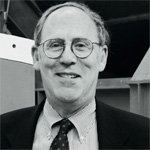Building bridges
Robert Eisenstein started work on experiments at CERN in 1980. He is now President of the Santa Fe Institute in the United States. Earlier in his career, while at the US National Science Foundation, he played a significant role in organizing the partnership of the United States and the Large Hadron Collider project.
 “Of the two experiments at LEAR I worked on, one is still going on in some ways. Over almost 25 years this rather small experiment has produced some 30 PhDs, with students from the United States, Germany, Sweden — a remarkable thing. It was probably the best collaboration I ever worked on, with wonderful colleagues, a truly international effort...
“Of the two experiments at LEAR I worked on, one is still going on in some ways. Over almost 25 years this rather small experiment has produced some 30 PhDs, with students from the United States, Germany, Sweden — a remarkable thing. It was probably the best collaboration I ever worked on, with wonderful colleagues, a truly international effort...
To my mind, CERN remains the prime example of international cooperation in science. Some other institutions have tried to emulate the CERN example but without the same success. The role CERN played in helping international relations, especially during the Cold War, is very substantive. It allowed communication in science between countries that were not talking to each other otherwise.
What CERN created after the Second World War is very subtle, with its complete openness at a time when that was desperately needed. Everybody was welcome — all they needed was a good idea. This principle still holds today. I always enjoyed bringing students here, because CERN is always exciting and interesting.
It is important to remember back to the beginning. Fifty years ago, Europe was devastated. CERN was built with the goal of beginning to rebuild and reunify European science. The intention was to do this independently of the United States – and to be honest, the United States did not want to join as they had their own programme.
CERN therefore developed independently, but the United States had a supporting role. And then Victor Weisskopf became Director-General — this was a brilliant choice. He was a European who became an American, but who remained always a citizen of the world. He was a tremendously important figure in helping build bridges, and to keep up a spirit of trust and co-operation.
Of course there is also a natural and healthy competition between CERN and the United States. There is nothing wrong with it — it helps us both to be sharp, clever and discovery-oriented. This has been something of enormous value to both sides.
Today, the United States is strongly involved in the LHC project. Co-operation is now more important than ever because particle physics is at a crossroads. All particle physicists have to work together to see that the future is secure. CERN has an important role to play, and I am sure that it will do this.
Some things are easy to overlook. It is easy to take for granted the co-operation and friendly exchange — but this is very rare and very hard to do. CERN has been such a great success, which sometimes is not appreciated as much as it could be.”

